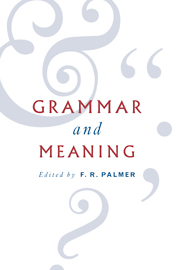Book contents
- Frontmatter
- Contents
- List of contributors
- Foreword
- 1 Polysemous relations
- 2 Fields, networks and vectors
- 3 Syntax, semantics, pragmatics
- 4 Natural-language interpretation as labelled natural deduction
- 5 Three levels of meaning
- 6 Does spoken language have sentences?
- 7 Grammaticalisation and social structure: non-standard conjunction-formation in East Anglian English
- 8 German Perfekt and Präteritum: speculations on meaning and interpretation
- 9 The possessed
- 10 Complement clauses and complementation strategies
- 11 Grammar and meaning
- John Lyons: publications
- Index
10 - Complement clauses and complementation strategies
Published online by Cambridge University Press: 30 January 2010
- Frontmatter
- Contents
- List of contributors
- Foreword
- 1 Polysemous relations
- 2 Fields, networks and vectors
- 3 Syntax, semantics, pragmatics
- 4 Natural-language interpretation as labelled natural deduction
- 5 Three levels of meaning
- 6 Does spoken language have sentences?
- 7 Grammaticalisation and social structure: non-standard conjunction-formation in East Anglian English
- 8 German Perfekt and Präteritum: speculations on meaning and interpretation
- 9 The possessed
- 10 Complement clauses and complementation strategies
- 11 Grammar and meaning
- John Lyons: publications
- Index
Summary
Grammar exists to code meaning. Every language has a similar set of semantic tasks to fulfil. There is a universal pool of grammatical construction types, and each language draws its own selection from the pool. According to the selection that is made, a similar type of meaning may be expressed by different grammatical means in different languages.
But the variation is not random. Each construction type in a language has a semantic effect, and although a given meaning may be expressed in different languages by constructions that are grammatically diverse, they will have similar semantics. This will be illustrated for complementation strategies in the Australian language Dyirbal, which are compared with the familiar complement clause constructions in English, and in Fijian.
Section 1 discusses the appropriate part of the semantic task which all languages have to perform; section 2 sketches the varied grammatical means for achieving it, paying attention to the different kinds of interclausal relation found in human languages; section 3 deals with complement clauses in English and Fijian; section 4 then discusses complementation strategies (which do not involve complement clauses per se) in Dyirbal; section 5 summarises the results and shows that verbs with similar meaning take complement clauses or complementation strategies, with similar meanings, across widely diverse languages.
The semantic task
The words of any language can be grouped into a number of lexical classes called SEMANTIC TYPES, which have a common meaning component and some shared grammatical properties.
- Type
- Chapter
- Information
- Grammar and MeaningEssays in Honour of Sir John Lyons, pp. 175 - 220Publisher: Cambridge University PressPrint publication year: 1995
- 50
- Cited by



